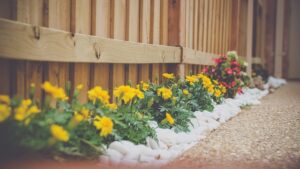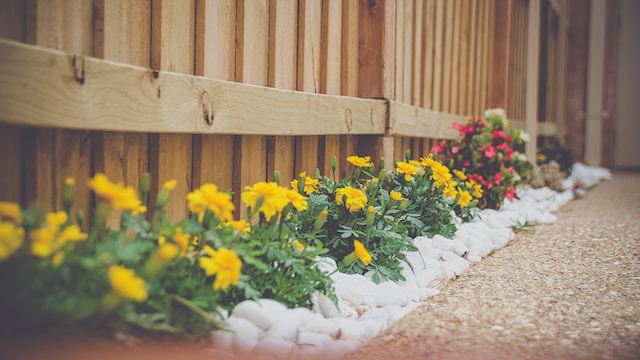Kentucky Landscaping involves incorporating different elements of nature into your property to create a visually pleasing aesthetic. This can include anything from plants to structures, and it can be used to complement your home or even to define spaces on your property.

Landscaping is the art of transforming outdoor spaces into a cohesive and harmonious whole. This can add visual appeal and value to a property and provide environmental benefits. It involves using plants, trees, shrubs, flowers, and lawns to create a pleasing aesthetic. Landscaping can include hardscape elements, such as patios, walkways, and retaining walls. Landscaping is a complex process, and it is essential to keep in mind the different steps involved in order to achieve success.
The first step in designing a landscape is choosing the type of look you want to achieve. Do you want a formal, contemporary or rustic style? A landscaper can help you decide what types of plants will best fit your desired look and provide the most benefits.
Once you’ve chosen a look, it’s time to start planning the layout of your landscape. It is important to think about how you plan on using the space and what other features you might like to incorporate, such as a garden or water feature. This will help you determine what materials you’ll need and how much space is required.
It is also important to consider how your landscaping will affect the surrounding environment. For example, you should be aware of how your design will impact drainage and how much sun or shade the area will receive. This will affect the type of plants you choose and how often they need to be watered.
Landscapes can be divided into two main categories – hardscape and softscape. Hardscape elements include anything that is not living, such as rocks, concrete and paving. Softscape elements include grass, trees, flowers and shrubs. Landscaping can be used to create a variety of effects, from creating a privacy fence to providing shade and improving air quality.
Landscaping is not only a way to beautify your home or business, but it can also improve the health and well-being of your family and employees. Studies have shown that working in a green environment can help people feel happier and more productive. In addition, commercial landscaping can increase the value of a property and attract customers and clients.
Maintenance
Whether you’re looking to boost property values or just improve the appearance of your outdoor spaces, landscaping can be a great investment. But, like any home improvement project, proper maintenance is key. Regular landscaping tasks like mowing the lawn, pruning plants and removing debris are essential to keeping your outdoor spaces beautiful. And if you want your landscape to last, it’s important to use high-quality materials and tools.
Landscapers use horticultural skills to come up with creative ideas associated with softscapes (plants) and construction knowledge to build paving, decking, fences, irrigation systems and other hardscape features. They also maintain landscapes by mowing, mulching, weeding and pest management.
Landscaping can be done on both residential and commercial properties. Residential landscaping focuses on lawns and gardens, while commercial landscaping consists of outdoor areas around offices and industrial sites.
A well-planned and maintained landscape can increase property values by 5% to 12%. This is because a beautiful landscape attracts potential buyers and can make your property more appealing to renters or buyers.
The best way to create a stunning garden is to work with a professional landscaping service. But, if you’re on a budget, DIY landscaping may be a more practical option. Regardless of the type of landscaping you choose, the following tips will help you achieve your goals.
Maintaining a landscape requires an immense amount of work. It’s essential to hire the right people for the job and have the best equipment available. Using landscape business software, like ToolSense, to manage equipment inspections and inventory helps you eliminate staffing emergencies and keep your crews productive.
Landscapers must be able to respond quickly to unexpected challenges. This is especially true in winter when weather and unforeseen plant problems can make landscapes more difficult to work on. By having a team that is equipped to handle any challenges they encounter, landscapers can maximize efficiency and avoid costly mistakes.
The old saying “an ounce of prevention is worth a pound of cure” certainly applies to landscaping. Keeping up with regular maintenance, addressing issues as they arise and using the best tools and equipment available will help you avoid costly repairs down the road.
Planting
Landscaping involves planting trees, shrubs and flowers, creating outdoor living spaces and gardens, laying walkways, installing retaining walls, water features, fences, and more. It is an important part of any home or business, as it enhances the visual appeal of the property and increases the value of the land. It also provides many benefits, such as reducing air pollution, improving mental health, and encouraging physical activity.
When designing a landscape, it is important to consider the needs of the plants as well as their aesthetics. For example, if you are planning to grow fruit trees, it is important to choose species that can withstand the climate of your region. In addition, it is important to plant them properly in order to maximize their growth potential. Incorporate shade and wind breaks where needed, and plan for future expansion by including space for root balls in the layout.
A well-designed landscape can increase a property’s value by up to 12%. This makes it an excellent investment, and it can be a great way to express your personal style and taste. However, it is important to remember that a good landscaping project requires time and money. For this reason, it is a good idea to work with a professional landscaper.
Another important aspect of landscaping is maintenance. Maintaining the landscape includes tasks such as watering, fertilizing, and controlling weeds and pests. It can also include pruning, mulching, mowing, and cleaning paved surfaces and structures. In addition, maintaining the landscape can help to reduce erosion and improve air quality.
One of the most important aspects of running a landscaping business is marketing. This is how you attract customers and keep them coming back. It is also a way to set yourself apart from competitors and show customers that you are reliable.
When choosing advertising and marketing methods, it is important to think long-term. Many businesses only focus on attracting new clients, but this can be detrimental to the business in the long run. It is better to invest in a strong marketing strategy and build customer loyalty.
Installation
Landscapes are designed to enhance the beauty of a property, but they can also serve a number of practical purposes, such as providing shade and privacy. In addition, landscaping can increase the value of a home and improve its functionality. It involves a variety of activities, including altering the terrain, planting trees and shrubs, and installing structures such as patios and walkways.
The first step in landscape installation is to plan out your design. Begin by sketching out a map of the yard, and include any hardscape items that will remain in place (e.g., pathways, fences, walls, structures). It’s a good idea to include a rough estimate of the cost for these elements at this point as well. This will help you avoid costly surprises down the road.
Once you have a solid plan in place, it’s time to begin the actual work. Before you start, though, make sure to set a realistic budget and stick to it. This will prevent you from overextending yourself and ensure that your project is a success. If you’re unsure of how to proceed, consider hiring a professional landscaping company with experienced professionals to take care of the details for you.
During the landscape installation process, it’s important to use high-quality tools and materials. This will ensure that your finished product is both beautiful and long-lasting. In addition, be sure to properly maintain your equipment to keep it running in top condition. Finally, be sure to hire a reliable crew and supervise them closely to minimize mistakes. It’s also helpful to have a journal to record your ideas, inspiration, and learnings as you go along.
Once the landscape fabric is in place, it’s time to install the edging and stones that will form the border around the beds. This will help to prevent weeds from growing through the fabric and prevent the fabric from getting damaged. In order to properly install the edging, it’s important to measure and mark each line before starting the cutting process.
The final step in the landscaping installation process is to secure the fabric to the ground using garden staples. This will help prevent the weeds from growing through the landscape fabric and will also help to keep the soil in place. The best part about landscape fabric is that it’s easy to install and doesn’t require much upkeep once it’s down.


